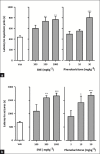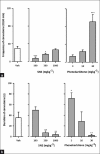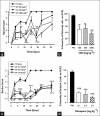Anticonvulsant and related neuropharmacological effects of the whole plant extract of Synedrella nodiflora (L.) Gaertn (Asteraceae)
- PMID: 22557925
- PMCID: PMC3341718
- DOI: 10.4103/0975-7406.94816
Anticonvulsant and related neuropharmacological effects of the whole plant extract of Synedrella nodiflora (L.) Gaertn (Asteraceae)
Abstract
Purpose: The plant Synedrella nodiflora (L) Gaertn is traditionally used by some Ghanaian communities to treat epilepsy. To determine if this use has merit, we studied the anticonvulsant and other neuropharmacological effects of a hydro-ethanolic extract of the whole plant using murine models.
Materials and methods: The anticonvulsant effect of the extract (10-1000 mg/kg) was tested on the pentylenetetrazole-, picrotoxin-, and pilocarpine-induced seizure models and PTZ-kindling in mice/rats. The effect of the extract was also tested on motor coordination using the rota-rod.
Results: The results obtained revealed that the extract possesses anticonvulsant effects in all the experimental models of seizures tested as it significantly reduced the latencies to myoclonic jerks and seizures as well as seizure duration and the percentage severity. The extract was also found to cause motor incoordination at the higher dose of 1000 mg/kg.
Conclusions: In summary, the hydro-ethanolic extract of the whole plant of S. nodiflora possesses anticonvulsant effects, possibly through an interaction with GABAergic transmission and antioxidant mechanisms and muscle relaxant effects. These findings thus provide scientific evidence in support of the traditional use of the plant in the management of epilepsy.
Keywords: Kindling; Synedrella nodiflora; pentylenetetrazole; picrotoxin; pilocarpine.
Conflict of interest statement
Figures









References
-
- McNamara JO, Bonhaus DW, Shin CY. Cambridge, UK: Cambridge University Press; 1993. The kindling model of epilepsy. Epilepsy: Models, Mechanisms and Concepts; pp. 27–47.
-
- Regesta G, Tanganelli P. Clinical aspects and biological bases of drug-resistant epilepsies. Epilepsy Res. 1999;34:109–22. - PubMed
-
- Kwan P, Brodie MJ. Epilepsy after the first drug fails: substitution or add-on? Seizure. 2000;9:464–8. - PubMed
-
- Loscher W. Current status and future directions in the pharmacotherapy of epilepsy. Trends Pharmacol Sci. 2002;23:113–8. - PubMed
-
- McNamara JO. Emerging insights into the genesis of epilepsy. Nature. 1999;399(6738 Suppl):A15–22. - PubMed

